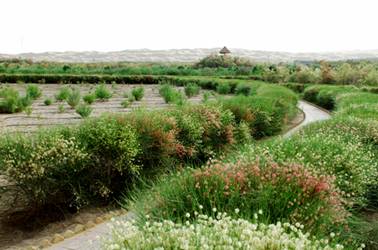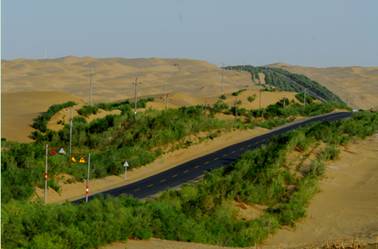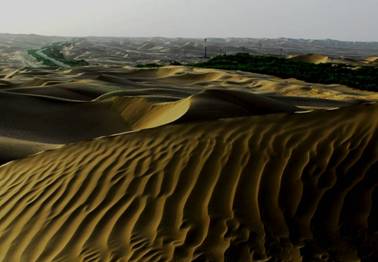Taklimakan Station for Desert Research, XIEG, CAS
The Station was established in 2003 and approved as a member of the Special Environmental Observation Station Network by CAS in 2007. The Station is the only research base for systematic observation and experimentation located in the center of the Taklimakan Desert.
It is located in the Taklimakan Desert at 39?00′N, 83°40′E at an altitude of 1,099.3 m above sea level in Qiemo county.


Tazhong Eremophytes Botanical Garden
The local climate is extremely arid and rainless, with mean annual precipitation of 10.7 mm and mean evaporation of 3,806.4 mm. More than 82% of its area is covered by drifting sand dunes. The landform is dominated by highly complex sand-ridges and broad flat inter-dunes. It is largely devoid of plants as well as surface runoff. There were a few plant and animal species found in the desert area, including 5 animal species such as Araneida, Lepus yarkandensis, Dipus sagitta, Meriones meridianus, Camelus bactrianus, and 19 plant species that belong to eight families such as T. taklamakanensis M. T. Liu, Phragmites communis Trin, Bidens parviflora Willd, Calligonum mongolicum Turcz., Heliotropium micranthum (Pall.) Bge, etc.

Hedgerow of Calligonum L.
Research Fields
(1) Monitoring aeolian environments and the movement processes of windblown sand in the hinterland of the Taklimakan Desert
(2) Windblown sand disasters and the stability regarding the sustainable utilization of 436 km of cross-desert green corridor
(3) Monitoring environmental changes and ecological processes of the new man-made oases on the desert margins
(4) Technical issues of management, maintenance and renewal of forest belts

Shelterbelts ecological project along the Tarim Desert Highway

Mobile sand dunes in the Taklimakan Desert

Tarim Desert Highway
Infrastructures, Routine Experiments and Monitoring
The infrastructures of the Taklimakan Station for Desert Research includes: (1) living-office building and experiment building; (2) botanical garden; (3) sites to monitor about the protecting effects of physical sand-protecting systems and biological sand-protecting systems; and (4) comprehensive weather station, wind erosion monitoring station, groundwater environment monitoring station, atmospheric dust fall monitoring station.
Routine experiments and monitoring are about water, soil, air, and biology. The following studies have been made at a range of temporal and spatial scales: (1) The patterns of shifting wind-blown sand and the processes of their formation; (2) Conditions for dust storm occurrence; (3) Plant responses to multiple stresses; (4) Patterns of soil, water and salt movement; (5) Stability of ecological shelter projects; (6) Selection and cultivation of plant species with highresistance to environmental stresses; (7) Development of special desert biological resources; (8) The processes of desert formation and evolution; (9) Ecological processes and adverse stress resistance mechanisms of animals and plants under extreme environmental conditions.
Major Accomplishments
Based on more than 10 years of systematic research, the Station has:
(1) Recognized movement patterns of wind blown sand in the Taklimakan Desert, and formulated a classification standard for sand disasters for desert highways.
Main Publications
Lei J Q, Wang X Q, Wang D, et al. 2002. The blown sand disaster to the Tarim Desert Highway in Xinjiang, China. Science in China: Series D, 45(Supp.): 165–173.
Lei J Q, Li S Y, Fan D D, et al. 2008. Classification and regionalization of the forming environment of windblown sand disasters along the Tarim Desert Highway. Chinese Science Bulletin, 53(Supp. II): 1–7.
(2) Developed a site type classification system for the Taklimakan Desert, improved plant species selection technology for extreme environmental conditions, selected appropriate wind-calming and sand-binding plant species suitable for the Taklimakan Desert, developed an integrated, innovative technological system of irrigation for afforestation in shifting desert areas, widened the range of water quality and the range of water resources that can be used for engineering construction in arid areas.
Main Publications
Li B W, Xu X W, Lei J Q, et al. 2008. Site type classification for the shelter-forest ecological project along the Tarim Desert Highway. Chinese Science Bulletin, 53(Suppl. II): 31–40.
Wang Y D, Xu X W, Lei J Q, et al. 2008. The dynamics variation of soil moisture of shelterbelts along the Tarim Desert Highway. Chinese Science Bulletin, 53(Suppl. II): 102–108.
The shelterbelt ecological project along the Taklimakan Desert Highway was chosen as one of the Top-ten News Stories of Scientific and Technological Progress selected by academicians of CAS and CAE in 2006. The research also received a National Second Prize for Scientific and Technological Progress in China.
(3) Confirmed the suitability of the structure patterns for large-scale shelterbelt systems in desert areas, analyzed and evaluated the comprehensive effects of the shelterbelt ecological project along the Taklimakan Desert Highway, optimized and improved sustainable management and protection technology for large-scale shelterbelt projects in shifting desert areas.
Main Publications
Lei J Q, Li S Y, Jin Z Z, et al. 2008. Comprehensive eco-environmental effects of the shelter-forests ecological engineering along the Tarim Desert Highway. Chinese Science Bulletin, 53(Suppl. II): 190–202.
Li S Y, Lei J Q, Xu X W, et al. 2008. Topographical changes of ground surface affected by the shelterbelt along the Tarim Desert Highway. Chinese Science Bulletin, 53(Suppl. II): 8–21.
Jin Z Z, Lei J Q, Xu X W, et al. 2008. Evaluation of soil fertility of the shelter-forest land along the Tarim Desert Highway. Chinese Science Bulletin, 53(Suppl. II): 125–136.
Fan J L, Xu X W, Lei J Q, et al. 2008. The temporal and spatial fluctuation of the groundwater level along the Tarim Desert Highway. Chinese Science Bulletin, 53(Suppl. II): 53–62.
The shelterbelt ecological project along the Taklimakan Desert Highway was honored as one of top-ten environmentally-friendly engineering projects in China in 2008.

The Taklimakan Desert
Personnel
There are 30 research staffs in the Station, including 1 professor, 2 associate professors and 1 senior engineer.
There are currently 9 postgraduate students in the Station, including 4 PhD candidates and 5 MSc candidates.
Contact
Director: XU Xinwen
Tel: +86-991-7823139
E-mail: sms@ms.xjb.ac.cn
- Appendix
-



